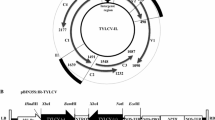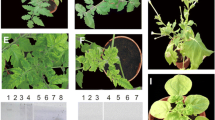Abstract
In tomato line H24, an isolate of the Mild (Mld) strain of tomato yellow leaf curl virus (TYLCV-Mld [JR:Kis]) overcomes Ty-2 gene–mediated resistance and causes typical symptoms of tomato yellow leaf curl disease (TYLCD). No systemic infection with visible symptoms or accumulation of viral DNA in the upper leaves was observed in H24 challenged with another isolate, TYLCV-IL (TYLCV-IL [JR:Osaka]), confirming that H24 is resistant to the IL strain. To elucidate the genomic regions that cause the breakdown of the Ty-2 gene–mediated resistance, we constructed a series of chimeras by swapping genes between the two strains. A chimeric virus that had the overlapping C4/Rep region of the Mld strain in the context of the IL strain genome, caused severe TYLCD in H24 plants, suggesting that the overlapping C4/Rep region of the Mld strain is associated with the ability of this strain to overcome Ty-2 gene–mediated resistance.



Similar content being viewed by others
References
Amin I, Patil BL, Briddon RW, Mansoor S, Fauquet CM (2011) Comparison of phenotypes produced in response to transient expression of genes encoded by four distinct begomoviruses in Nicotiana benthamiana and their correlation with the levels of developmental miRNAs. Virol J 8:238
Barbieri M, Acciarri N, Sabatini E, Sardo L, Accotto GP, Pecchioni N (2010) Introgression of Resistance to two mediterranean virus species causing tomato yellow leaf curl into a valuable traditional tomato variety. J Plant Pathol 92:485–493
Bisaro DM (2006) Silencing suppression by geminivirus proteins. Virology 344:158–168
Brown J, Fauquet C, Briddon R, Zerbini F, Moriones E, Navas-Castillo J (2012) Family Geminiviridae. In: King AMQ, Adams MJ, Carstens EB, Lefkowitz EJ (eds) Virus taxonomy ninth report of the international committee on taxonomy of viruses. Elsevier, San Diego, pp 351–373
Brown JK, Zerbini FM, Navas-Castillo J, Moriones E, Ramos-Sobrinho R, Silva JC, Fiallo-Olive E, Briddon RW, Hernandez-Zepeda C, Idris A, Malathi VG, Martin DP, Rivera-Bustamante R, Ueda S, Varsani A (2015) Revision of Begomovirus taxonomy based on pairwise sequence comparisons. Arch Virol 160:1593–1619
Butterbach P, Verlaan MG, Dullemans A, Lohuis D, Visser RGF, Bai YL, Kormelink R (2014) Tomato yellow leaf curl virus resistance by Ty-1 involves increased cytosine methylation of viral genomes and is compromised by cucumber mosaic virus infection. Proc Natl Acad Sci USA 111:12942–12947
Caciagli P, Medina Piles V, Marian D, Vecchiati M, Masenga V, Mason G, Falcioni T, Noris E (2009) Virion stability is important for the circulative transmission of tomato yellow leaf curl sardinia virus by Bemisia tabaci, but virion access to salivary glands does not guarantee transmissibility. J Virol 83:5784–5795
Cohen S, Nitzany F (1966) Transmission and host range of the tomato yellow leaf curl virus. Phytopathology 56:1127–1131
Cui XF, Zhou XP (2004) AC2 and AC4 proteins of tomato yellow leaf curl China virus and tobacco curly shoot virus mediate suppression of RNA silencing. Chin Sci Bull 49:2607–2612
Czosnek H (2007) Interaction of tomato yellow leaf curl virus with its whitefly vector. In: Czosnek H (ed) Tomato yellow leaf curl virus disease: management, molecular biology, breeding for resistance. Springer, Berlin, pp 157–170
Diaz-Pendon JA, Canizares MC, Moriones E, Bejarano ER, Czosnek H, Navas-Castillo J (2010) Tomato yellow leaf curl viruses: menage a trois between the virus complex, the plant and the whitefly vector. Mol Plant Pathol 11:441–450
Garcia BE, Graham E, Jensen KS, Hanson P, Mejía L, Maxwell DP (2007) Co-dominant SCAR marker for detection of the begomovirus-resistance Ty-2 locus derived from Solanum habrochaites in tomato germplasm. Rpt Tomato Genet Coop 57:21–24
Hanley-Bowdoin L, Settlage SB, Robertson D (2004) Reprogramming plant gene expression: a prerequisite to geminivirus DNA replication. Mol Plant Pathol 5:149–156
Hanley-Bowdoin L, Bejarano ER, Robertson D, Mansoor S (2013) Geminiviruses: masters at redirecting and reprogramming plant processes. Nat Rev Microbiol 11:777–788
Hanson P, Green S, Kuo G (2006) Ty–2, a gene on chromosome 11 conditioning geminivirus resistance in tomato. Rep Tomato Genet Coop 56:11–18
Hanson PM, Bernacchi D, Green S, Tanksley SD, Muniyappa V, Padmaja S, Chen HM, Kuo G, Fang D, Chen JT (2000) Mapping a wild tomato introgression associated with tomato yellow leaf curl virus resistance in a cultivated tomato line. J Am Soc Hortic Sci 125:15–20
Ji Y, Schuster DJ, Scott JW (2007) Ty-3, a begomovirus resistance locus near the tomato yellow leaf curl virus resistance locus Ty-1 on chromosome 6 of tomato. Mol Breed 20:271–284
Jupin I, De Kouchkovsky F, Jouanneau F, Gronenborn B (1994) Movement of tomato yellow leaf curl geminivirus (TYLCV): involvement of the protein encoded by ORF C4. Virology 204:82–90
Kalloo Banerjee MK (1990) Transfer of tomato leaf curl virus-resistance from Lycopersicon-Hirsutum F Glabratum to L Esculentum. Plant Breed 105:156–159
Kato K, Onuki M, Fuji S, Hanada K (1998) The first occurrence of tomato yellow leaf curl virus in tomato (Lycopersicon esculentum Mill.) in Japan. Ann Phytopatol Soc Jpn 64:552–559
Krake LR, Rezaian MA, Dry IB (1998) Expression of the tomato leaf curl geminivirus C4 gene produces viruslike symptoms in transgenic plants. Mol Plant Microbe Interact 11:413–417
Lefeuvre P, Martin DP, Harkins G, Lemey P, Gray AJ, Meredith S, Lakay F, Monjane A, Lett JM, Varsani A, Heydarnejad J (2010) The spread of tomato yellow leaf curl virus from the Middle East to the world. PLoS Pathog 6:e1001164
Luna AP, Morilla G, Voinnet O, Bejarano ER (2012) Functional analysis of gene-silencing suppressors from tomato yellow leaf curl disease viruses. Mol Plant Microbe Interact 25:1294–1306
Navas-Castillo J, Sanchez-Campos S, Noris E, Louro D, Accotto GP, Moriones E (2000) Natural recombination between tomato yellow leaf curl virus-is and tomato leaf curl virus. J Gen Virol 81:2797–2801
Noris E, Jupin I, Accotto GP, Gronenborn B (1996) DNA-binding activity of the C2 protein of tomato yellow leaf curl geminivirus. Virology 217:607–612
Noris E, Vaira AM, Caciagli P, Masenga V, Gronenborn B, Accotto GP (1998) Amino acids in the capsid protein of tomato yellow leaf curl virus that are crucial for systemic infection, particle formation, and insect transmission. J Virol 72:10050–10057
Ohnishi J, Kitamura T, Terami F, K-i Honda (2009) A selective barrier in the midgut epithelial cell membrane of the nonvector whitefly Trialeurodes vaporariorum to tomato yellow leaf curl virus uptake. J Gen Plant Pathol 75:131–139
Prasanna HC, Kashyap S, Krishna R, Sinha DP, Reddy S, Malathi VG (2015) Marker assisted selection of Ty-2 and Ty-3 carrying tomato lines and their implications in breeding tomato leaf curl disease resistant hybrids. Euphytica 204:407–418
Prasanna HC, Sinha DP, Rai GK, Krishna R, Kashyap SP, Singh NK, Singh M, Malathi VG (2015) Pyramiding Ty-2 and Ty-3 genes for resistance to monopartite and bipartite tomato leaf curl viruses of India. Plant Pathol 64:256–264
Rigden JE, Dry IB, Mullineaux PM, Rezaian MA (1993) Mutagenesis of the virion-sense open reading frames of tomato leaf curl geminivirus. Virology 193:1001–1005
Rigden JE, Krake LR, Rezaian MA, Dry IB (1994) ORF C4 of tomato leaf curl geminivirus is a determinant of symptom severity. Virology 204:847–850
Rojas MR, Jiang H, Salati R, Xoconostle-Cazares B, Sudarshana MR, Lucas WJ, Gilbertson RL (2001) Functional analysis of proteins involved in movement of the monopartite begomovirus, tomato yellow leaf curl virus. Virology 291:110–125
Saito A, Saito T, Matsunaga H, Yamada H (2008) Evaluation of commercial cultivars resistant to tomato yellow leaf curl virus using quantitative real-time PCR in tomato (Solanum lycopersicum). Hortic Res (Japan) 7:107 (in Japanese)
Scholthof KB, Adkins S, Czosnek H, Palukaitis P, Jacquot E, Hohn T, Hohn B, Saunders K, Candresse T, Ahlquist P, Hemenway C, Foster GD (2011) Top 10 plant viruses in molecular plant pathology. Mol Plant Pathol 12:938–954
Settlage SB, See RG, Hanley-Bowdoin L (2005) Geminivirus C3 protein: replication enhancement and protein interactions. J Virol 79:9885–9895
Shahid MS, Ito T, Kimbara J, Onozato A, Natsuaki KT, Ikegami M (2013) Evaluation of tomato hybrids carrying Ty-1 and Ty-2 Loci to Japanese Monopartite Begomovirus species. J Phytopathol 161:205–209
Tomas DM, Canizares MC, Abad J, Fernandez-Munoz R, Moriones E (2011) Resistance to tomato yellow leaf curl virus accumulation in the tomato wild relative Solanum habrochaites associated with the C4 viral protein. Mol Plant Microbe Interact 24:849–861
Tsai WS, Shih SL, Kenyon L, Green SK, Jan FJ (2011) Temporal distribution and pathogenicity of the predominant tomato-infecting begomoviruses in Taiwan. Plant Pathol 60:787–799
Ueda S, Kimura T, Onuki M, Hanada K, Iwanami T (2004) Three distinct groups of isolates of tomato yellow leaf curl virus in Japan and construction of an infectious clone. J Gen Plant Pathol 70:232–238
Vanitharani R, Chellappan P, Pita JS, Fauquet CM (2004) Differential roles of AC2 and AC4 of cassava geminiviruses in mediating synergism and suppression of posttranscriptional gene silencing. J Virol 78:9487–9498
Vidavski F (2007) Exploitation of resistance genes found in wild tomato species to produce resistant cultivars; Pile up of Resistant Genes. In: Czosnek H (ed) Tomato yellow leaf curl virus disease. Springer, Netherlands, pp 363–372
Xie Y, Zhao L, Jiao X, Jiang T, Gong H, Wang B, Briddon RW, Zhou X (2013) A recombinant begomovirus resulting from exchange of the C4 gene. J Gen Virol 94:1896–1907
Yamaguchi H, Ohnishi J, Miyatake K, Nunome T, Ohyama A, Negoro S, Fukuoka H (2013) A simple, efficient agroinoculation soaking procedure for tomato yellow leaf curl virus. J Gen Plant Pathol 79:243–248
Zamir D, Ekstein-Michelson I, Zakay Y, Navot N, Zeidan M, Sarfatti M, Eshed Y, Harel E, Pleban T, van-Oss H, Kedar N, Rabinowitch HD, Czosnek H (1994) Mapping and introgression of a tomato yellow leaf curl virus tolerance gene, TY-1. Theor Appl Genet 88:141–146
Zhang J, Dong J, Xu Y, Wu J (2012) V2 protein encoded by tomato yellow leaf curl China virus is an RNA silencing suppressor. Virus Res 163:51–58
Zrachya A, Glick E, Levy Y, Arazi T, Citovsky V, Gafni Y (2007) Suppressor of RNA silencing encoded by tomato yellow leaf curl virus-Israel. Virology 358:159–165
Author information
Authors and Affiliations
Corresponding author
Ethics declarations
Conflict of interest
The authors declare that they have no conflict of interest.
Ethical approval
This article does not contain any studies with human participants or animals performed by any of the authors.
Rights and permissions
About this article
Cite this article
Ohnishi, J., Yamaguchi, H. & Saito, A. Analysis of the Mild strain of tomato yellow leaf curl virus, which overcomes Ty-2 gene–mediated resistance in tomato line H24. Arch Virol 161, 2207–2217 (2016). https://doi.org/10.1007/s00705-016-2898-4
Received:
Accepted:
Published:
Issue Date:
DOI: https://doi.org/10.1007/s00705-016-2898-4




